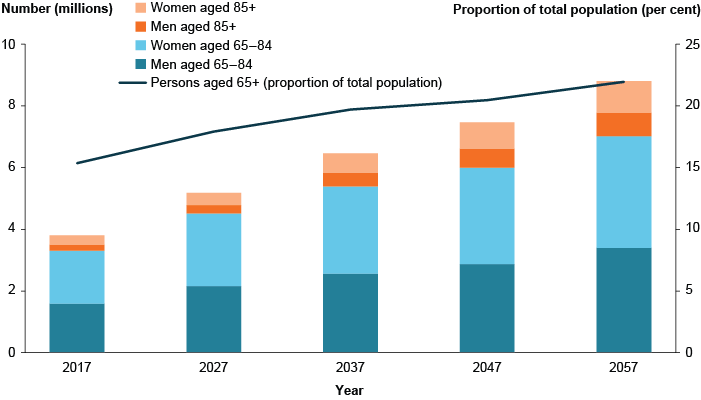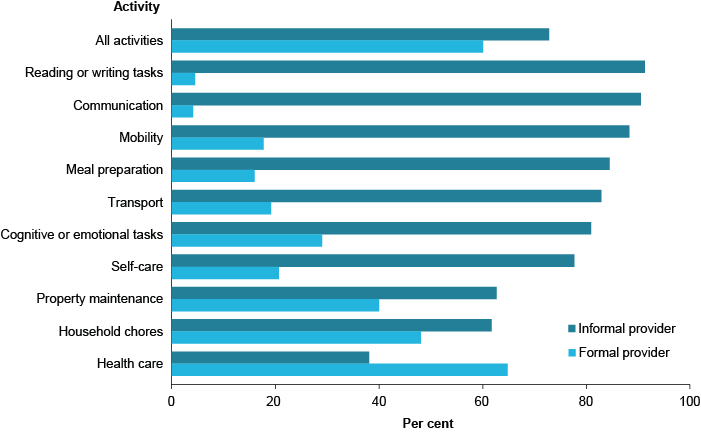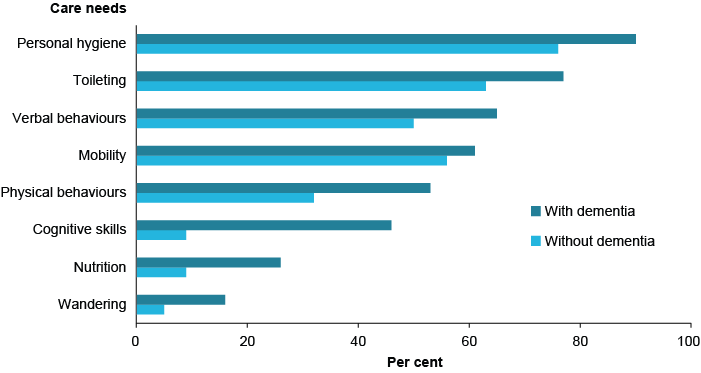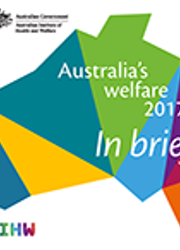Ageing and aged care
Australia's population is ageing. This demographic shift presents a range of challenges and opportunities for older Australians and the wider community.
The number of people aged 65 and over in Australia is projected to more than double, to 8.8 million, over the next 40 years.
Number and proportion of the population aged 65 and over, by age group and sex, 30 June 2017, 2027, 2037, 2047 and 2057

As the population grows and more Australians reach advanced old age, the number of people with dementia is expected to rise. Dementia is a leading cause of disability in older Australians. It brings a substantial burden for people with dementia, their family members and caregivers (often one and the same), and increasing cost to government.
An estimated 365,000 Australians had dementia in 2017, 99% of whom were aged 60 and over. The number of people affected by dementia is projected to rise considerably, to 900,000 by 2050.
Informal carers—the main form of support for older people
Many older Australians (aged 65 and over) want to remain in their own homes as they age, and most do so. Only 5% of older Australians live in cared accommodation (like nursing homes).
Almost 40% of older people living in households or cared accommodation need assistance with at least one activity (such as household chores or meal preparation). More assistance to older people living at home is provided by informal providers (73%) than formal providers (60%) but this varies, depending on the type of activity.
Activity type and provider type for older Australians aged 65 and over living in households who needed assistance, 2015

Find out more: Chapter 5.1 'Ageing and aged care' in Australia's welfare 2017.
People with dementia require greater levels of care
In 2017, an estimated 365,000 people were living with dementia.
Almost half (49%) of people with dementia in 2015 lived in cared accommodation (such as residential aged care facilities) and nearly all had an associated disability.
Also, more than half (52%) of the people living in permanent residential aged care as at 30 June 2016 had dementia. On entry to permanent residential aged care, people's care needs are assessed. These assessments show that people with dementia were more likely to be rated as requiring a 'high' level of assistance with nearly all types of care than residents without dementia. This was particularly so for cognitive skills (5 times as likely as people without dementia to be rated as 'most dependent'), wandering (3.2 times) and nutrition (2.9 times).
Proportion of people in permanent residential aged care with/without dementia who were assessed as most dependent, by selected types of care needs, as at 30 June 2016

Find out more: Chapter 5.2 'Dementia and people's need for help from others' in Australia's welfare 2017.



